- Home
- Peter F. Hamilton
A Second Chance at Eden
A Second Chance at Eden Read online
Peter F. Hamilton was born in Rutland in 1960, and still lives near Rutland Water. He began writing in 1987 and sold his first short story to Fear magazine in 1988. He has also been published in Interzone and the In Dreams and New Worlds anthologies, and in several small-press publications. His novels include the Greg Mandel series: Mindstar Rising, A Quantum Murder and The Nano Flower; and the bestselling Night’s Dawn trilogy: The Reality Dysfunction, The Neutronium Alchemist and The Naked God. Also published by Macmillan (and Pan) is The Confederation Handbook, a vital guide to the Night’s Dawn trilogy. His most recent novels are Misspent Youth, Pandora’s Star, Judas Unchained and The Dreaming Void.
Also by Peter F. Hamilton
The Greg Mandel series
Mindstar Rising
A Quantum Murder
The Nano Flower
The Night’s Dawn trilogy
The Reality Dysfunction
The Neutronium Alchemist
The Naked God
In the same Timeline
The Confederation Handbook
(a vital guide to the Night’s Dawn trilogy)
Fallen Dragon
Misspent Youth
The Commonwealth Saga
Pandora’s Star
Judas Unchained
The Void trilogy
The Dreaming Void
Peter F. Hamilton
A SECOND CHANCE
AT EDEN
PAN BOOKS
First published 1998 by Macmillan
This edition first published 1999 by Pan Books
This electronic edition published 2008 by Pan Books
an imprint of Pan Macmillan Ltd
Pan Macmillan, 20 New Wharf Rd, London N1 9RR
Basingstoke and Oxford
Associated companies throughout the world
www.panmacmillan.com
ISBN 978-0-330-46895-4 in Adobe Reader format
ISBN 978-0-330-46894-7 in Adobe Digital Editions format
Copyright © Peter F. Hamilton 1998
‘Sonnie’s Edge’ first published in New Moon magazine September 1991,
copyright © Peter F. Hamilton 1991
‘Candy Buds’ first published in New Worlds #2,1992,
copyright © Peter F. Hamilton 1992
‘Deathday’ first published in Fear magazine February 1991,
copyright © Peter F. Hamilton 1991
‘The Lives and Loves of Tiarella Rosa’ appeared in a different form as ‘Spare Capacity’ in New Worlds #3 1993,
copyright © Peter F. Hamilton 1993
‘Escape Route’ first published in Interzone July 1997,
copyright © Peter F. Hamilton 1997
The right of Peter F. Hamilton to be identified as the author of this work has been asserted by him in accordance with the Copyright, Designs and Patents Act 1988.
You may not copy, store, distribute, transmit, reproduce or otherwise make available this publication (or any part of it) in any form, or by any means (electronic, digital, optical, mechanical, photocopying, recording or otherwise), without the prior written permission of the publisher. Any person who does any unauthorized act in relation to this publication may be liable to criminal prosecution and civil claims for damages.
A CIP catalogue record for this book is available from the British Library.
Visit www.panmacmillan.com to read more about all our books and to buy them. You will also find features, author interviews and news of any author events, and you can sign up for e-newsletters so that you’re always first to hear about our new releases.
To David Garnett
because, like many of us, I owe him.
Contents
Introduction
Sonnie’s Edge
A Second Chance at Eden
New Days Old Times
Candy Buds
Deathday
The Lives and Loves of Tiarella Rosa
Escape Route
Introduction
The stories assembled for this collection are set in the universe of my ‘Night’s Dawn Trilogy’. Now, they form a series of snapshot glimpses into the history of the Confederation leading up to the time of Joshua Calvert and Quinn Dexter. It wasn’t always so.
During the early nineties I wrote several short stories centred around the affinity technology. They didn’t belong to any particular hard and fast version of future history, I was just interested in the potential of the idea. Then along came David Garnett, who had just bought ‘Candy Buds’ for his New Worlds anthology, and said: You should turn this into a novel.
Impossible, I told him.
That was back in the days of my foolish youth, before I learnt the hard way that the editor is always right.
He convinced me to go away and think about it. ‘Night’s Dawn’ was the result. OK, so I didn’t get the last laugh, but at least I managed to frighten him with the size of volume one, The Reality Dysfunction, all 374,000 words of it.
As to the stories themselves, some are new, some have appeared in magazines before, in which case I’ve altered them slightly so they fit into the Confederation timeline.
Peter F. Hamilton
Rutland, February 1998
Timeline
2020 Cavius base established. Mining of Lunar subcrustal resources starts.
2037 Beginning of large-scale geneering on humans; improvement to immunology system, organ efficiency increased.
2041 First deuterium-fuelled fusion stations built; inefficient and expensive.
2044 Christian reunification.
2047 First asteroid capture mission. Beginning of Earth’s O’Neill Halo.
2049 Quasi-sentient bitek animals employed as servitors.
2055 Jupiter mission.
2055 Lunar cities granted independence from founding companies.
2057 Ceres asteroid settlement founded.
2058 Affinity symbiont neurones developed by Wing-Tsit Chong, providing control over animals and bitek constructs.
2064 Jovian Sky Power Corporation (JSKP) industrial consortium formed, begins mining Jupiter’s atmosphere for He3, using aerostat factories.
2064 Islamic secular unification.
2067 Fusion stations begin to use He3 as fuel.
2069 Affinity bond gene spliced into human DNA.
Sonnie’s Edge
Earth 2070
Sonnie’s Edge
It was daylight, so Battersea was in gridlock. The M500 motorway above the Thames had taken us right into the heart of London at a hundred and fifty kilometres an hour, then after we spiralled down an off ramp onto the Chelsea Bridge our top speed braked to a solid 1 k.p.h. Our venue was another three kilometres ahead of us.
We joined the queue of chrome-silver vehicles jamming the street, turning up the reflectivity of our own windscreen against the glare. Bikes slithered through the narrow gaps, their riders in slick-skinned kooler suits. Lighthorns flared and blared in fury as they cut through the two-way tailback, chasing after them like some kind of runway strobe effect. As if that wasn’t bad enough, every vehicle on the road was humming urgently, hub motors and air-conditioning vibrating the air at a frequency guaranteed to induce a migraine. Three hours of that.
I hate cities.
Midday, and we rolled into the derelict yard like an old-fashioned circus caravan come to town. I was driver’s mate to Jacob, sitting up in the ageing twenty-wheeler’s cab, feet up to squash the tideline of McWrappers littering the dash. Curious roadies from the arena were milling about on the fractured concrete, staring up at us. The other two vans in our team’s convoy turned in off the road. A big pair of dilapidated metal gates clanged shut behind us.
Jacob locked the wheels and turned off the power cell. I climbed down out
of the cab. The silvered side of the lorry was grimy from the city’s airplaque, but my reflection was clear enough. Blonde bob hairstyle that needs attention; same goes for the clothes, I guess: sleeveless black T-shirt and olive-green Bermuda shorts I’ve had for over a year, feet crammed into fraying white plimsolls. I’m twenty-two, though I’ve got the kind of gaunt figure thirty-year-old women have when they work out and diet hard to make themselves look twenty-two again. My face isn’t too bad; Jacob rebuilt it to give me the prominent cheekbones I’d always wanted as a teenager. Maybe it wasn’t as expressive as it used to be, but the distorting curves of the lorry’s bodywork made it hard to tell.
Outside the cab’s insulation, London’s sounds hit me square on, along with its heat and smell. The three major waste products of eighteen million consumers determined to preserve their lifestyle by spending and burning their way through domestic goodies and energy at a rate only twenty-first century industry can supply. And even that struggles to keep up with demand.
I can plug straight into that beautiful hive of greed; their need for a byte of the action. I know what they want best of all, and we provide it for them.
Excitement, that’s how me and the rest of Sonnie’s Predators suckle our money. And we’ve brought a big unique chunk of it here to Battersea. Tonight, there’s gonna be a fight.
Beastie-baiting: the all-time blood sport; violent, spectacularly gory, and always lethal. It’s new and it’s happening; universes away from the sanitized crap of VR games consumers load into their taksuit processor each night. This is real, it ignites the old instincts, the strongest and most addictive of all. And Sonnie’s Predators are the hottest team to storm ashore in the two years since the contests started. Seventeen straight wins. We’ve got Baiter groupies howling for us all the way from the Orkney Islands down to Cornwall.
I was lucky, signing up at level one, when all the rage was modifying Rottweilers and Dobermanns with fang implants and razor claws. A concept I bet poor old Wing-Tsit Chong never thought of when he invented the affinity bond.
Karran and Jacob were the team’s nucleus, fresh out of Leicester University with their biotechnology degrees all hot and promising. They could have gone to any company in the world with those qualifications, plunged straight into the corporate universe of applied research and annual budget squabbles. It’s an exchange millions of graduates make each year, zest for security, and the big relief of knowing your student loans will be paid off. But that was about the time when the Pope started appeasing the Church’s right wing, and publicly questioned the morality of affinity and the way it was used to control animals. It didn’t take long for the mullahs to join the chorus. The whole biotechnology ethics problem became prime topic for newscable studios; not to mention justification for a dozen animal-rights activists to launch terminal action campaigns against biotechnology labs. Suddenly, establishment biotechnology wasn’t so enticing.
If they didn’t start paying off the student loan within six months of graduation, the bank would just assign them to a company (and take an agency fee from their salary). Baiting was the only financially viable alternative for their talent.
Ivrina was an ex-surgical nurse who had just started helping them with grafting techniques when I arrived. A drifter with little ambition, even less education, but just enough sense to realize this was different, something I could immerse myself in, maybe even make a go of. It was new for everybody, we were all beginners and learners. They took me on as a driver and general dogsbody.
Wes joined three months later. A hardware specialist, or nerd, depending on your prejudice. An essential addition to a sport whose sophistication was advancing on a near-daily basis. He maintained the clone vats, computer stacks, and Khanivore’s life-support units, plus a thousand other miscellaneous units.
We were doing all right, Jacob’s Banshees, as we were known back then, battling hard for cult status. A decent win ratio, pushing sixty per cent. Jacob and Karran were still massively in debt, but they were making the monthly interest payments. The purse money was enough to keep us independent while our contemporaries were scrambling for syndicate backing. Poor but proud, the oldest kick in the book. Waiting for the whole sport to earn cable interest and turn big time. It would happen, all the teams knew that.
Then I had my mishap, and acquired my killer edge.
The buzz from the hub motors on the other two vans faded away, and the rest of the team joined me among the weeds and cat pee of the yard’s concrete. According to a London Administration Council sign on the gates the yard had been designated as a site for one of the proposed Central-South Dome’s support pillars. Though God knows when construction would ever begin. Central-North Dome was visible above the razor wire trimming the yard’s wall. A geodesic of amber-tinted crystal, four kilometres in diameter, squatting over most of the Westminster district like some kind of display case for the ancient stone buildings underneath. The struts were tiny considering the size of it, a type of superstrong fibre grown in orbit, glinting prismatically in the achingly bright sun. Empty gridworks for the Chelsea and Islington domes were already splintering the sky on either side of it. One day all cities will be like this, sheltering from the hostile climate which their own thermal emission has created. London doesn’t have smog any more. Now it just has heat shimmer, the air wobbling in the exhaust vents of twenty-five million conditioning nozzles. The ten largest ones are sitting on the Central-North dome, like black barnacles spewing out the surplus therms in huge fountains of grey haze. London Administration Council won’t allow planes to fly over it for fear of what those giant lightless flames will do to airflow dynamics.
Karran came over to stand beside me, setting a wide panama hat over her ruff of Titian hair. Ivrina stood a few paces back, wearing just a halter top and sawn-off jeans; UV proofing treatment had turned her Arctic-princess skin a rich cinnamon. Wes snaked an arm protectively round her waist as she sniffed disapprovingly at the grungy air.
‘So how’s the vibes, Sonnie?’ Karran asked.
They all fell silent, even Jacob who was talking to the roadie boss. If a Baiting team’s fighter hasn’t got the right hype then you just pack up and go straight home. For all their ingenuity and technical back-up, the rest of the team play no part in the bout. It’s all down to me.
‘Vibes is good,’ I told them. ‘I’ll have it wrapped in five minutes.’
There was only one time when I’d ever doubted. A Newcastle venue that matched us against the King Panther team. It turned into a bitch of a scrap. Khanivore was cut up pretty bad. Even then, I’d won. The kind of bout from which Baiter legends are born.
Ivrina punched a fist into her palm. ‘Atta girl!’ She looked hotwired, spoiling for trouble. Anyone would think she was going to boost Khanivore herself. She certainly had the right fire for it; but as to whether she had the nerve to go for my special brand of killer edge I don’t know.
It turned out that Dicko, the arena’s owner, was a smooth organizer. Makes a change. Some bouts we’ve wondered if the place even existed, never mind having backstage gofers. Jacob marshalled the roadies, and got them to unload Khanivore’s life-support pod from the lorry. His beefy face was sweating heavily as the opaque cylinder was slowly lifted down along with its ancillary modules. I don’t know why he worries so much about a two-metre drop. He does most of the beastie’s body design work (Karran handles the nervous system and circulatory network) so more than anyone he knows how tough Khanivore’s hide is.
The arena had started life as a vast tubing warehouse before Dicko moved in and set up shop. He kept the corrugated panel shell, stripping out the auto-stack machinery so he could grow a polyp pit in the centre – circular, fifteen metres in diameter, and four metres deep. It was completely surrounded by seating tiers, simple concentric circles of wooden plank benches straddling a spiderwork of rusty scaffolding. The top was twenty metres above the concrete floor, nearly touching the condensation-slicked roof panels. Looking at the rickety lash-up made me g
lad I wasn’t a spectator.
Our green room was the warehouse supervisor’s old office. The roadies grunted Khanivore’s life support into place on a set of heavy wooden trestles. They creaked but held.
Ivrina and I started taping black polythene over the filthy windows. Wes mated the ancillary modules with the warehouse’s power supply. Karran slipped on her Ishades, and began running diagnostic checks through Khanivore’s nervous system.
Jacob came in smiling broadly. ‘The odds are nine to two in our favour. I put five grand on us. Reckon you can handle that, Sonnie?’
‘Count on it. The Urban Gorgons have just acquired themselves one dead beastie.’
‘My girl,’ Wes said proudly, slapping my shoulder.
He was lying, which cut deep. Wes and I had been an inseparable pair for eight months, right up until my mishap. Now he and Ivrina were rocking the camper van’s suspension every night. I didn’t hold it against him, not consciously anyway. But seeing them walking everywhere together, arms entwined, necking, laughing – that left me cold.
An hour before I’m on, Dicko shows up. Looking at him, you kind of wondered how come he wound up in this racket. A dignified old boy, all formal manners and courteous smile; tall and thin, with bushy silver hair too thick to be entirely natural, and a slightly stiff walk which forced him to use a silver-topped cane. His garb was strictly last century: light grey suit with slim lapels, a white shirt with small maroon bow tie.
There was a girl in tow, mid-teens and nicely proportioned, sweet-faced, too; a fluff-cloud of curly chestnut hair framing a composed demure expression. She wore a simple square-necked lemon-yellow dress with a long skirt. I felt sorry for her. But it’s an ancient story; I get to see it countless times at each bout. At least it told me all I needed to know about Dicko and his cultivated mannerisms. Mr Front.

 A Night Without Stars
A Night Without Stars If at First . . .
If at First . . .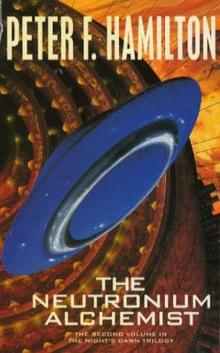 The Neutronium Alchemist
The Neutronium Alchemist Great North Road
Great North Road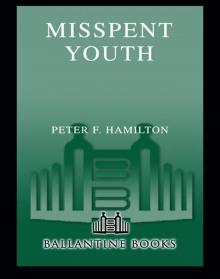 Misspent Youth
Misspent Youth Pandora's Star
Pandora's Star The Evolutionary Void
The Evolutionary Void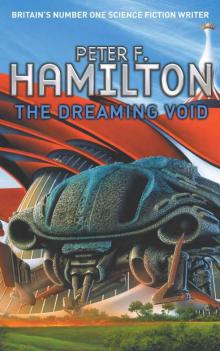 The Dreaming Void
The Dreaming Void Mindstar Rising
Mindstar Rising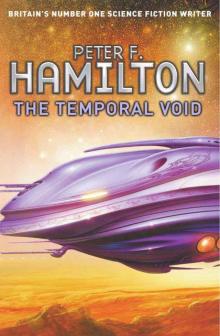 The Temporal Void
The Temporal Void A Quantum Murder
A Quantum Murder The Hunting of the Princes
The Hunting of the Princes Salvation Lost
Salvation Lost The Dreaming
The Dreaming Salvation
Salvation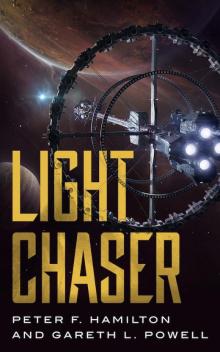 Light Chaser
Light Chaser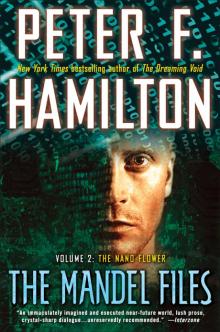 The Mandel Files, Volume 2: The Nano Flower
The Mandel Files, Volume 2: The Nano Flower![The Saints of Salvation [British Ed.] Read online](http://i1.bookreadfree.com/22/the_saints_of_salvation_british_ed__preview.jpg) The Saints of Salvation [British Ed.]
The Saints of Salvation [British Ed.] Manhattan in Reverse
Manhattan in Reverse The Secret Throne
The Secret Throne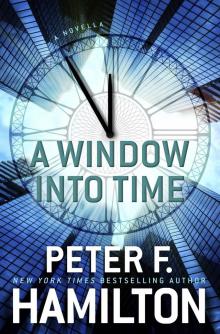 A Window Into Time
A Window Into Time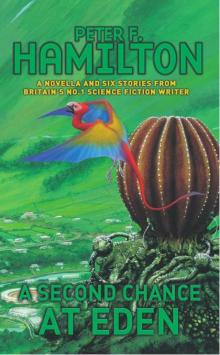 A Second Chance at Eden
A Second Chance at Eden The Nano Flower
The Nano Flower The Confederation Handbook
The Confederation Handbook The Naked God
The Naked God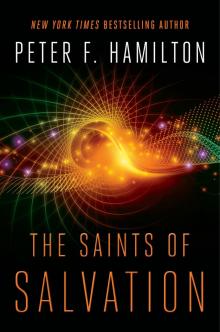 The Saints of Salvation
The Saints of Salvation The Void Trilogy 3-Book Bundle
The Void Trilogy 3-Book Bundle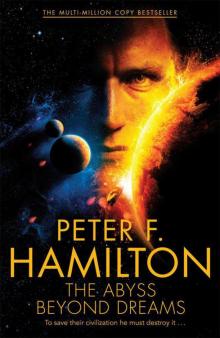 The Abyss Beyond Dreams
The Abyss Beyond Dreams A Voyage Through Air
A Voyage Through Air Judas Unchained
Judas Unchained The Commonwealth Saga 2-Book Bundle
The Commonwealth Saga 2-Book Bundle The Naked God - Flight nd-5
The Naked God - Flight nd-5 Night Without Stars (Chronicle of the Fallers Book 2)
Night Without Stars (Chronicle of the Fallers Book 2) Neutronium Alchemist - Conflict nd-4
Neutronium Alchemist - Conflict nd-4 Reality Dysfunction - Expansion nd-2
Reality Dysfunction - Expansion nd-2 Now We Are Ten: Celebrating the First Ten Years of NewCon Press
Now We Are Ten: Celebrating the First Ten Years of NewCon Press Neutronium Alchemist - Consolidation nd-3
Neutronium Alchemist - Consolidation nd-3 If at First . . . (Short Story)
If at First . . . (Short Story) A Second Chance at Eden nd-7
A Second Chance at Eden nd-7 Judas Unchained cs-2
Judas Unchained cs-2 The Mandel Files, Volume 1
The Mandel Files, Volume 1 Reality Dysfunction — Emergence nd-1
Reality Dysfunction — Emergence nd-1 The Temporal Void (ARC)
The Temporal Void (ARC)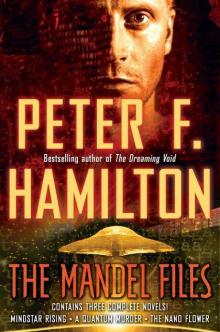 The Mandel Files
The Mandel Files Fallen Fragon
Fallen Fragon Misspent Youth (commonwealth saga)
Misspent Youth (commonwealth saga) If at First...
If at First... Best of British Science Fiction 2016
Best of British Science Fiction 2016 The Mandel Files, Volume 2
The Mandel Files, Volume 2 The Naked God - Faith nd-6
The Naked God - Faith nd-6 The Night's Dawn Trilogy
The Night's Dawn Trilogy Pandora's Star cs-2
Pandora's Star cs-2 A Window into Time (Novella)
A Window into Time (Novella)